11 Vintage Belt Buckles With Surprising Auction Prices
You may have an old belt buckle tucked away that could be worth serious money once shown to the right collector. Some of the highest prices come from pieces made by well-known manufacturers, or those that feature precious metals, gemstones or very limited production runs. A buckle in excellent condition with clear stamps or signatures is often the one that surprises at auction. Take a minute to check yours for hallmarks, design uniqueness and historical connection.
This post may contain affiliate links, which helps keep this content free. Please read our disclosure for more info.
King of the Cowboys Roy Rogers buckle
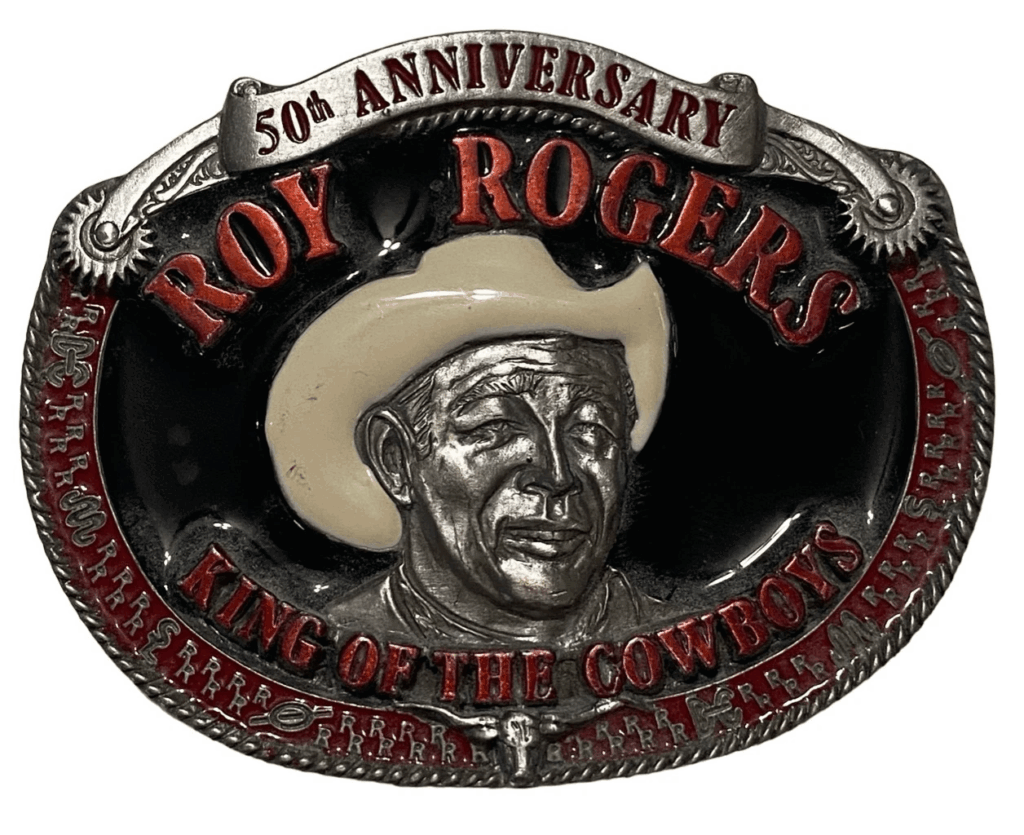
Produced around 1940s-50s, this western style buckle paid tribute to a legendary film star. It commands high value thanks to its connection with Rogers and scarcity of original theatre-issued examples. In one prominent sale it fetched approximately $69,000 USD at auction. Collectors prize the original hallmark, the cowboy motif and clean condition free of major scratches or bends. To evaluate one, check for clear signature markings and original box or leather strap.
When you look at the piece closely you’ll see how early western memorabilia carries strong appeal. The condition of the metal finish and presence of all original components raise value significantly. Versions with heavier plating or rare licensing marks often bring higher bids. Since many were used heavily and discarded after wear, surviving examples are rare. If you ever come across one in excellent condition you might be holding a true standout.
Alaska gold nugget and mammoth-ivory buckle
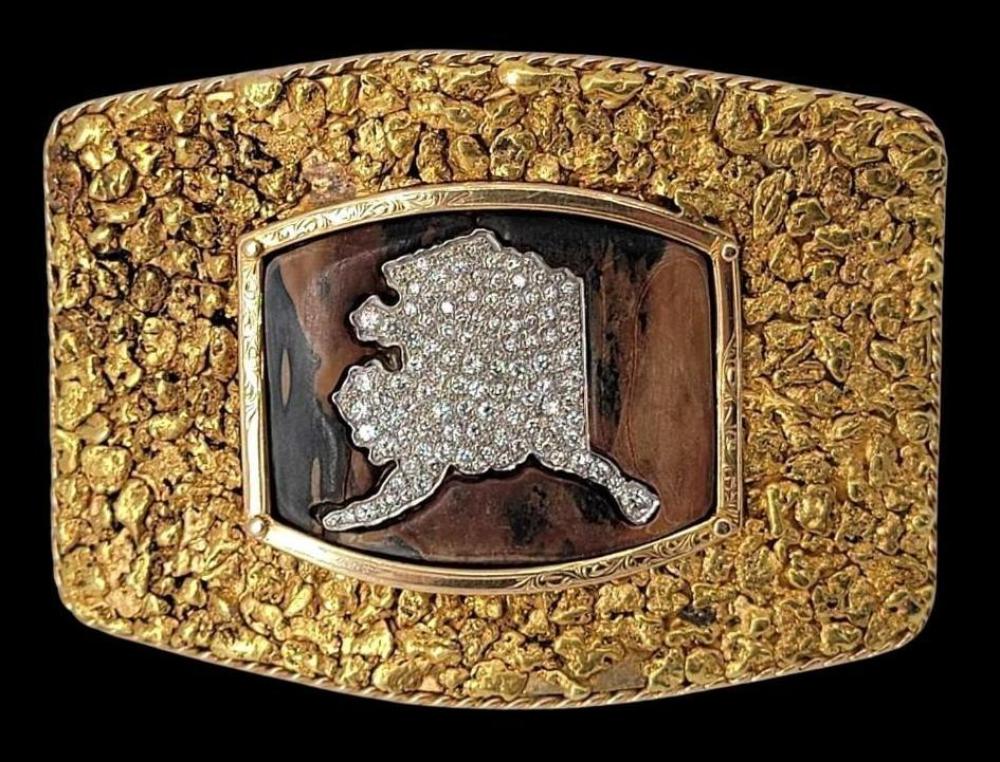
Made circa the 1970s, this buckle combines Alaska gold nuggets, mammoth ivory inlay and roughly 5 carats of diamonds. Its uniqueness comes from the exotic materials and the story tied to its origin in Alaska. An appraisal suggested its auction value could range between $20,000–$40,000 USD. The mix of gold, diamond and fossil ivory gives it appeal both as wearable accessory and as statement piece. Inspecting one means verifying gemstone quality, gold karat stamps and provenance of the mammoth ivory.
The rarity of materials and craftsmanship here make the piece stand out. Many vintage buckles are made of base metals or simple silver; this one uses premium materials. Because the seller originally paid far less, the dramatic value shift shows what materials plus provenance can do. When negotiating or purchasing one, ask for assay reports and any documentation showing source of nuggets or ivory. Even the buckle’s weight (in grams or ounces) can help confirm authenticity and value potential.
Designer sterling animal-figure buckle by Barry Kieselstein-Cord
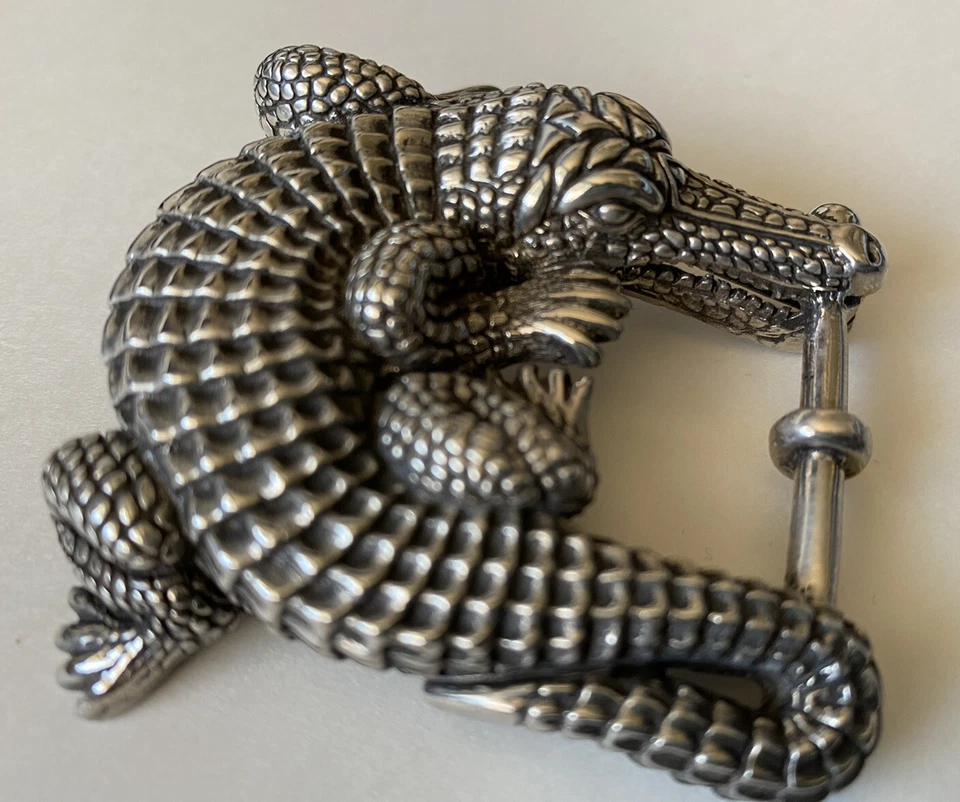
Circa 1980s–90s, this buckle features sterling silver with hall-marks and figure motifs (for example alligators or horses). What raises interest is the designer signature, high silver content and limited production. Auction records show these sell for a few hundred to several hundred dollars depending on design – for example, one sold around $425 USD. Condition matters a lot: look for original finish, minimal wear and full weight (no trimmed edges). The presence of the designer mark and original leather strap can push value upward.
Despite their lower price compared to gold or western rarities, these pieces are very collectible among fashion and accessory enthusiasts. They offer a sweet spot between rarity and wearability. Those made in silver rather than base metal carry more value. If you find one in pristine condition it’s worth comparing to recent auction listings for similar size and motif. Vintage designer accessories have seen attention, and a signed buckle ticks that box clearly.
Southwestern turquoise and sterling silver buckle
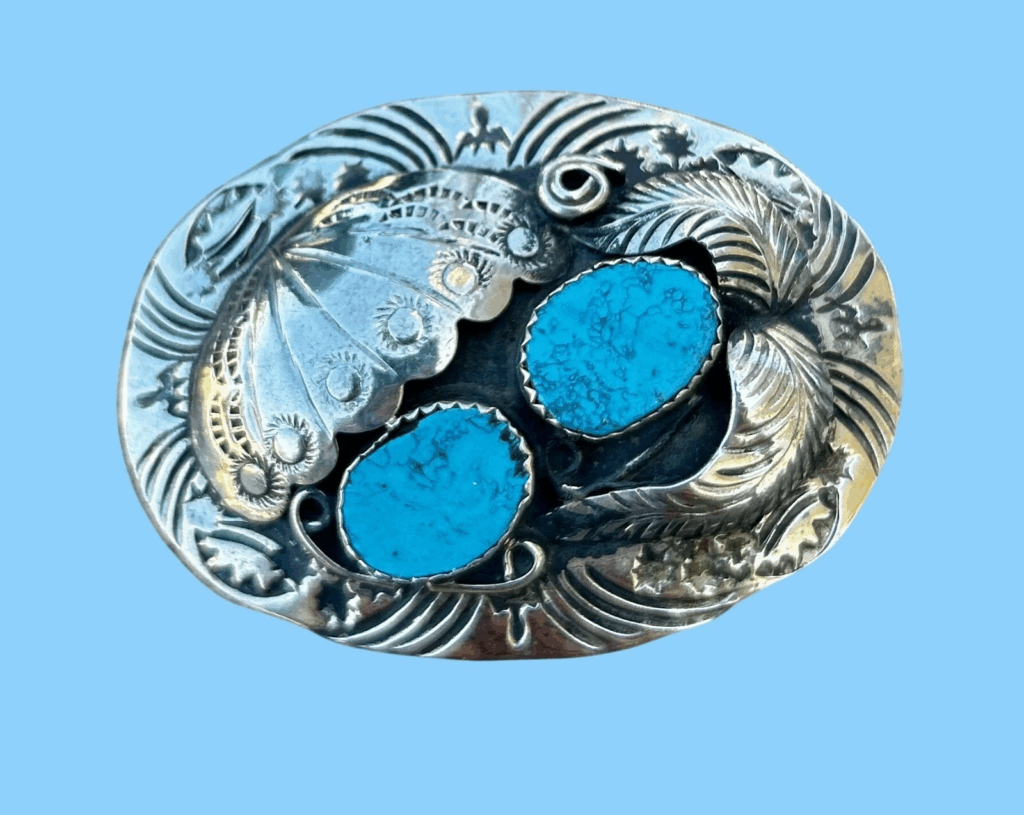
Made around the 1950s or 60s, this buckle features Native American silver work and turquoise stones inlaid in a western motif. Value comes from the artisan silver work, age and regional style that remains popular among collectors. Market listings show a fine example could be about $1,500–$3,000 USD. Condition of the turquoise (no cracks), preservation of the silver patina and the authenticity tag or signature add interest. Check whether the buckle is marked Sterling and any artisan’s mark like Navajo or Zuni.
In the realm of vintage western accessories, these buckles appeal to both fashion and folk-art collectors. The combination of turquoise colour and native silver work creates strong visual impact. If the piece retains its original leather belt or buckle backing that may increase value. Because many mid-century buckles were cleaned or polished excessively, those with original finish may command a premium. When you find one with good provenance and style you might have a standout.
Limited-edition film-tied buckle

This buckle was produced circa 1990s as part of a limited edition tied to a major film studio or celebrity promotion. Its collectible value emerges from the film connection, limited run quantity and condition of the buckle and licence plaque. Though specific public sale data is sparse, limited-edition film memorabilia buckles can fetch several thousand dollars when in mint condition. Key details to check include edition number (for example 1 of 1000), presence of original packaging and licence annotation on buckle. A design referencing the film’s logo or imagery adds appeal.
Because the film-linked buckle appeals to multiple collector audiences (film fans + buckle collectors), those few in excellent shape may bring strong results. Rarity of the series means such items are less common than general release buckles. If the buckle is still shrink-wrapped or unused, that can push value upward. Be aware of modern re-issues which may pollute the market-original release date numbering matters. A film tie-in enhances story and collectibility beyond materials alone.
Rodeo champion presentation buckle
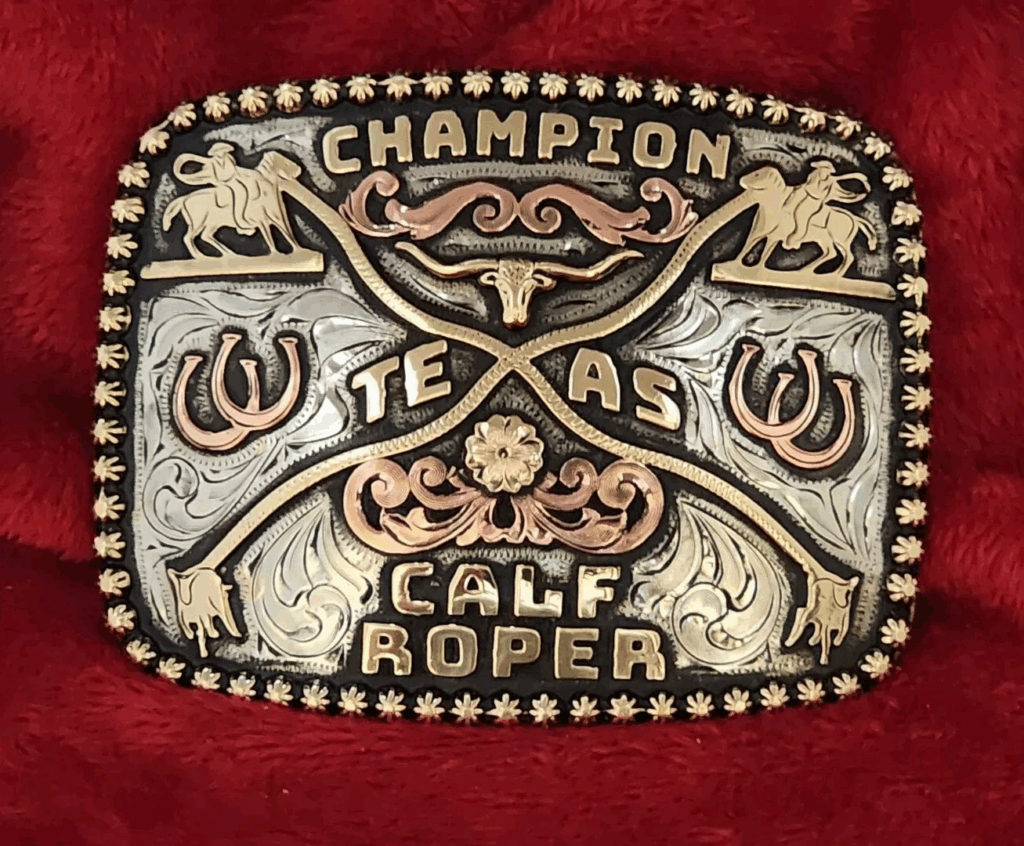
Constructed around the 1960s for a major rodeo winner, this belt buckle features heavy silver plating, engraving noting the champion’s name and event, and leather strap included. Its value comes from its presentation nature, event history and condition. Auction records show some of these presentation buckles reaching several thousand dollars depending on event and person. Important details include intact engraving, original strap, and minimal abrasions. For a high estimate imagine $3,000–$7,000 USD for a rare name and major rodeo event.
Because presentation pieces often have direct provenance, they offer stories that appeal to collectors. Confirm if the buckle retains original backings and strap clips. If you find a buckle from a well-known rodeo champion in good condition, you may have a particularly desirable item. Avoid buckles with heavy repolishing or replaced parts, which lessen value. Historical sport memorabilia and accessory markets sometimes overlap here.
Art-deco fashion buckle in gold-tone and enamel

Crafted around the 1930s, this fashion belt buckle features gold-tone metal with enamel highlights and an Art-Deco geometric design. The piece gains value thanks to the age, design era and good preservation of original enamel and finish. An estimate of market value might be roughly $1,000–$2,500 USD for a high-grade example. Look for original enamel without chips, no missing metal sections and the correct belt tongue hardware. Maker’s mark or original packaging can raise value further.
Since fashion pieces of that era were often worn into ruin, ones that survive in good shape draw serious interest. The Art-Deco aesthetic remains trendy among vintage accessory collectors. If the buckle retains original patina without heavy damage it stands out. Check that the enamel has not been repainted and that the buckle holds its shape. Presentation, condition and design era form the key triad of value here.
Royal presentation buckle (mid-20th century)
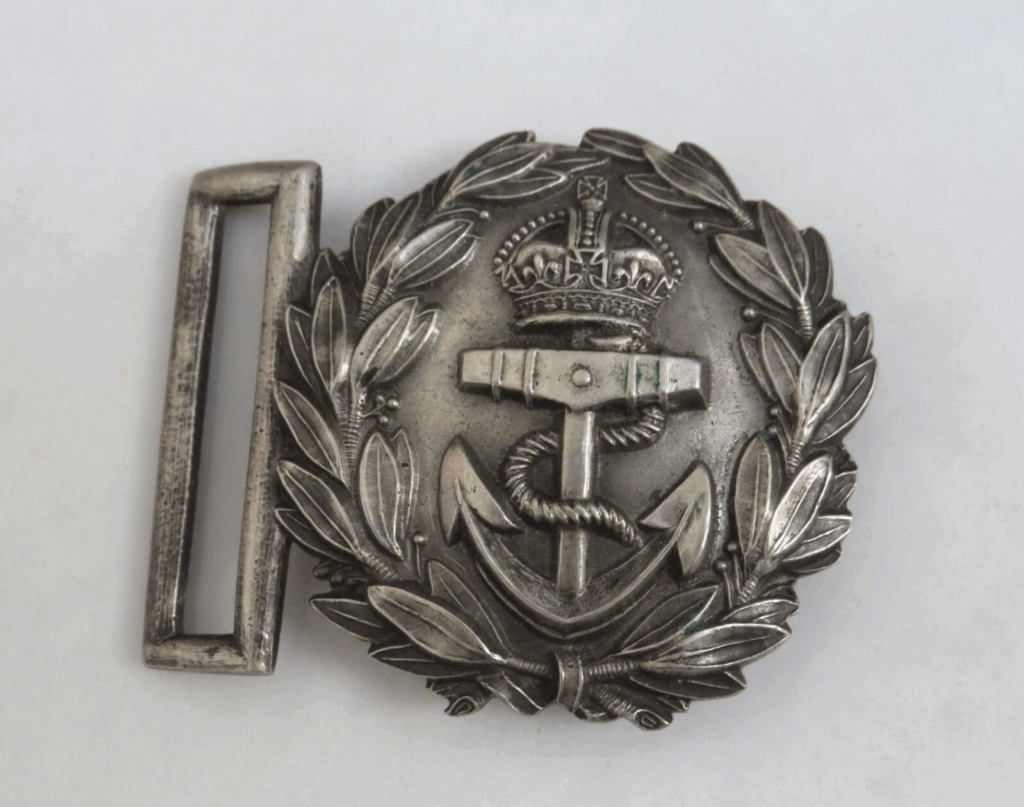
Produced in the 1950s for a royal or noble award ceremony, this buckle features plated gold elements, engraved insignia or crest, and often came with a certificate or presentation box. Its value comes from ceremony connection, limited issuance and good preservation. A plausible estimate might be around $5,000–$10,000 USD for one in excellent condition. Vital details include original insignia intact, presentation box or certificate present, and minimal surface wear. When you find one, check for the issuing body’s hallmark and serial number.
Because items tied to royalty or official awards often attract specialist collectors, condition and provenance matter significantly. Verifying the issuing ceremony and authenticity via engraving or archive records raises confidence. Keep an eye on surface wear, any tampering or replacement parts. If the buckle retains original attachments like straps or ribbons it may command premium. Collectors in decorative arts appreciate ceremonial accessories more than everyday wear pieces.
Native American silver and gold overlay buckle

Made in the 1970s by a recognized Native American silversmith, this buckle features silver body with gold overlay, turquoise stones and hand-engraved patterns. Its value arises from the artisan name, material quality and stone use. Estimated recent market value might sit around $4,000–$8,000 USD for a large piece in excellent condition. Key features to check include authentic maker’s stamp, weight of silver or gold, condition of stones and original strap. A provenance or exhibition history adds appeal.
Collectors of Native American jewellery and vintage western accessories often place premium on signed pieces. If the buckle has a documented history and remains unpolished with original finish, its value is stronger. Be wary of generic mass-produced overlays-those lack maker signature and often sell for less. Condition of stones (chips or missing inlays) matters a lot. Presentation case or original tag may elevate interest further.
Championship rodeo buckle from the 1950s
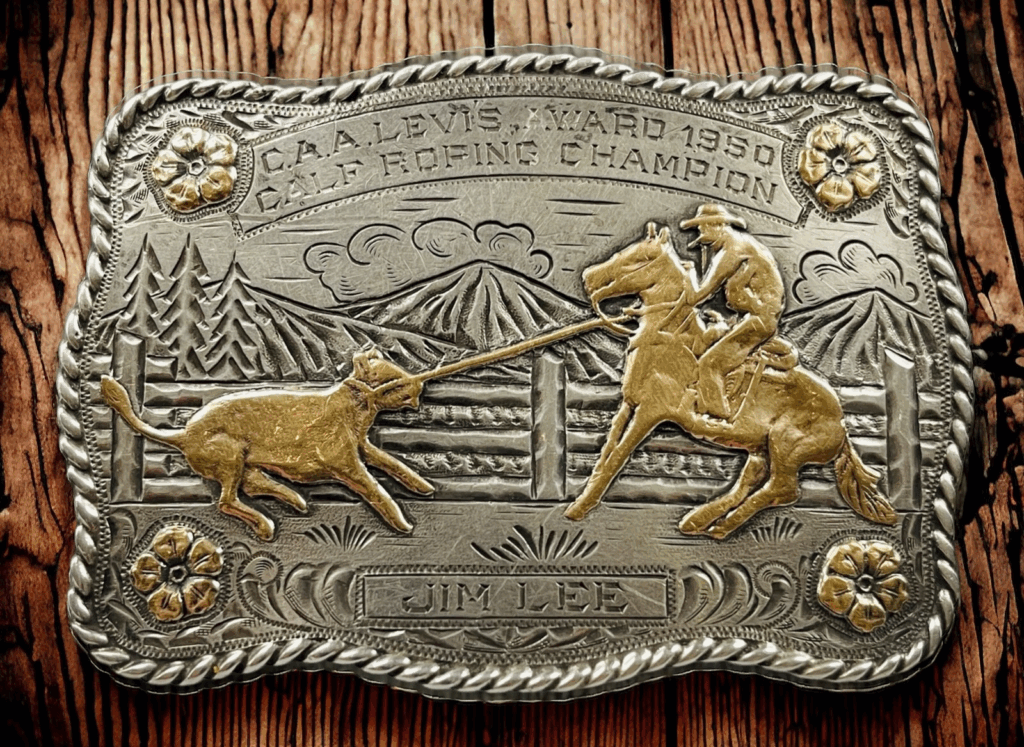
Issued circa 1950s to the winner of a large rodeo circuit, this buckle features heavy embossed silver plating, event title and year, and leather strap. The value emerges from event history, winner’s name engraved and size of the buckle. Some of these pieces sell for around $6,000–$12,000 USD depending on provenance. Key evaluation points include intact engraving, original strap, minimal wear on the high-points of embossing and original finish. Documentation showing the winner or event adds real value.
Because many smaller rodeo buckles were melted down or worn heavily, surviving examples with clear identifiers are rare. If the buckle’s event name is a major circuit (rather than local), that tends to increase interest. Original presentation boxes or plaques help elevate value. Excessive polish, replaced hardware or missing parts can reduce sale price. Collectors often treat these like sports trophies, where condition and history merge.
Limited brand-logo buckle from a luxury house

Produced around the 1980s by a luxury fashion brand, this buckle bears the company logo in gold-plate or vermeil finish, and sometimes a serial number. What makes it collectible is its brand heritage, limited production and crossover between fashion and accessory collecting. A recent value guide list put one example at $10,755 USD for fine condition. Evaluation should check for logo authenticity, correct serial number, original leather belt or packaging, and minimal wear of plating. Condition of the finish (no major peeling) is key.
Fashion-label buckles occupy a niche between accessories and collectables so condition and completeness matter a lot. If the buckle was part of a limited release or collaborated with a designer, it may bring higher bids. Watch out for modern replicas or re-issues which carry much lower value. Original box or papers attached to the buckle increase collector interest. Be sure to verify brand hallmarks and serial identifiers as part of your research.
This article originally appeared on Avocadu.
